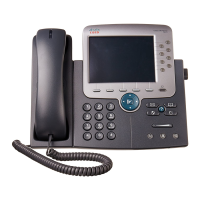Step 3
Add and configure the phone by completing the required fields in the Phone Configuration window. Required
fields are indicated by an asterisk (*) next to the field name; for example, MAC address and device pool.
Adds the device with its default settings to the Cisco Unified Communications Manager database.
See the Cisco Unified Communications Manager Administration Guide, “Cisco Unified IP Phone Configuration”
chapter. For information about Product Specific Configuration fields, refer to “?” button Help in the Phone
Configuration window.
Step 4
Add and configure directory numbers (lines) on the phone by completing the required fields in the Directory
Number Configuration window. Required fields are indicated by an asterisk (*) next to the field name; for
example, directory number and presence group.
Adds primary and secondary directory numbers and features associated with directory numbers to the phone.
See the Cisco Unified Communications Manager Administration Guide, “Directory Number Configuration”
chapter, and Telephony Features Available for Cisco Unified IP Phone, on page 124.
Step 5
Customize softkey templates.
Adds, deletes, or changes order of softkey features that display on the user phone to meet feature usage needs.
See the Cisco Unified Communications Manager Administration Guide, “Softkey Template Configuration”
chapter, and Softkey Templates, on page 153.
Step 6
Configure speed-dial buttons and assign speed-dial numbers (optional). Adds speed-dial buttons and numbers.
Users can change speed-dial settings on their phones by using the Cisco Unified Communications
Manager User Options web pages.
Note
See the Cisco Unified Communications Manager Administration Guide, “Cisco Unified IP Phone Configuration”
chapter.
Step 7
Configure Cisco Unified IP Phone services and assign services (optional). Provides IP Phone services.
Users can add or change services on their phones by using the Cisco Unified Communications
Manager User Options web pages.
Note
You must specify a service URL with an IPv4
address.
Note
See the Cisco Unified Communications Manager Administration Guide “Cisco Unified IP Phone Services
Configuration” chapter, and Services Setup, on page 153.
Step 8
Assign services to phone buttons (optional). Provides single-button access to an IP phone service or URL.
See the Cisco Unified Communications Manager Administration Guide, “Cisco Unified IP Phone Configuration”
chapter.
Step 9
Add user information by configuring required fields. Required fields are indicated by an asterisk (*); for
example, User ID and last name.
Assign a password (for User Options web pages) and PIN (for Extension Mobility and Personal
Directory).
Note
Adds user information to the global directory for Cisco Unified Communications Manager.
See Cisco Unified Communications Manager Administration Guide, “End User Configuration” chapter and
Cisco Unified Communications Manager User Addition, on page 154.
If your company uses a Lightweight Directory Access Protocol (LDAP) directory to store information
on users, you can install and configure Cisco Unified Communications to use your existing LDAP
directory, see Corporate Directory Setup, on page 149.
Note
Step 10
Associate a user to a user group. Assigns users a common list of roles and permissions that apply to all users
in a user group. Administrators can manage user groups, roles, and permissions to control the level of access
(and, therefore, the level of security) for system users.
Cisco Unified IP Phone 7975G, 7971G-GE, 7970G, 7965G, and 7945G Administration Guide for Cisco Unified
Communications Manager 9.0 (SCCP and SIP)
25
Cisco Unified IP Phone
Cisco Unified IP Phone Setup in Cisco Unified Communications Manager

